

Voyager 1 and 2: The Interstellar Mission

An image of Neptune taken by the Voyager 2 spacecraft. Image credit: NASA
NASA has beautiful photos of every planet in our solar system. We even have images of faraway Neptune , as you can see in the photo above.
Neptune is much too distant for an astronaut to travel there with a camera. So, how do we have pictures from distant locations in our solar system? Our photographers were two spacecraft, called Voyager 1 and Voyager 2!

An artist’s rendering of one of the Voyager spacecraft. Image credit: NASA
The Voyager 1 and 2 spacecraft launched from Earth in 1977. Their mission was to explore Jupiter and Saturn —and beyond to the outer planets of our solar system. This was a big task. No human-made object had ever attempted a journey like that before.
The two spacecraft took tens of thousands of pictures of Jupiter and Saturn and their moons. The pictures from Voyager 1 and 2 allowed us to see lots of things for the first time. For example, they captured detailed photos of Jupiter's clouds and storms, and the structure of Saturn's rings .

Image of storms on Jupiter taken by the Voyager 1 spacecraft. Image credit: NASA
Voyager 1 and 2 also discovered active volcanoes on Jupiter's moon Io , and much more. Voyager 2 also took pictures of Uranus and Neptune. Together, the Voyager missions discovered 22 moons.
Since then, these spacecraft have continued to travel farther away from us. Voyager 1 and 2 are now so far away that they are in interstellar space —the region between the stars. No other spacecraft have ever flown this far away.
Where will Voyager go next?
Watch this video to find out what's beyond our solar system!
Both spacecraft are still sending information back to Earth. This data will help us learn about conditions in the distant solar system and interstellar space.
The Voyagers have enough fuel and power to operate until 2025 and beyond. Sometime after this they will not be able to communicate with Earth anymore. Unless something stops them, they will continue to travel on and on, passing other stars after many thousands of years.
Each Voyager spacecraft also carries a message. Both spacecraft carry a golden record with scenes and sounds from Earth. The records also contain music and greetings in different languages. So, if intelligent life ever find these spacecraft, they may learn something about Earth and us as well!

A photo of the golden record that was sent into space on both Voyager 1 and Voyager 2. Image credit: NASA/JPL-Caltech
More about our universe!

Where does interstellar space begin?

Searching for other planets like ours

Play Galactic Explorer!
If you liked this, you may like:
Voyager 1 Perspective for Family Portrait

This simulated view, made using NASA's Eyes on the Solar System app, approximates Voyager 1's perspective when it took its final series of images known as the "Family Portrait of the Solar System," including the "Pale Blue Dot" image. Figure 1 shows the location of each image.
Keep Exploring
- Solar System
- Imaging Science Subsystem - Narrow Angle
- Voyager 1 Pictures
- Interstellar Pictures
- Nasa Pictures
- Outer Space Pictures
- Solar System Pictures
- Deep Space Pictures
- Satellite Pictures
Voyager 1 Space Probe Pictures
A excellent pictures of a Voyager 1 space probe with galaxy sky view.
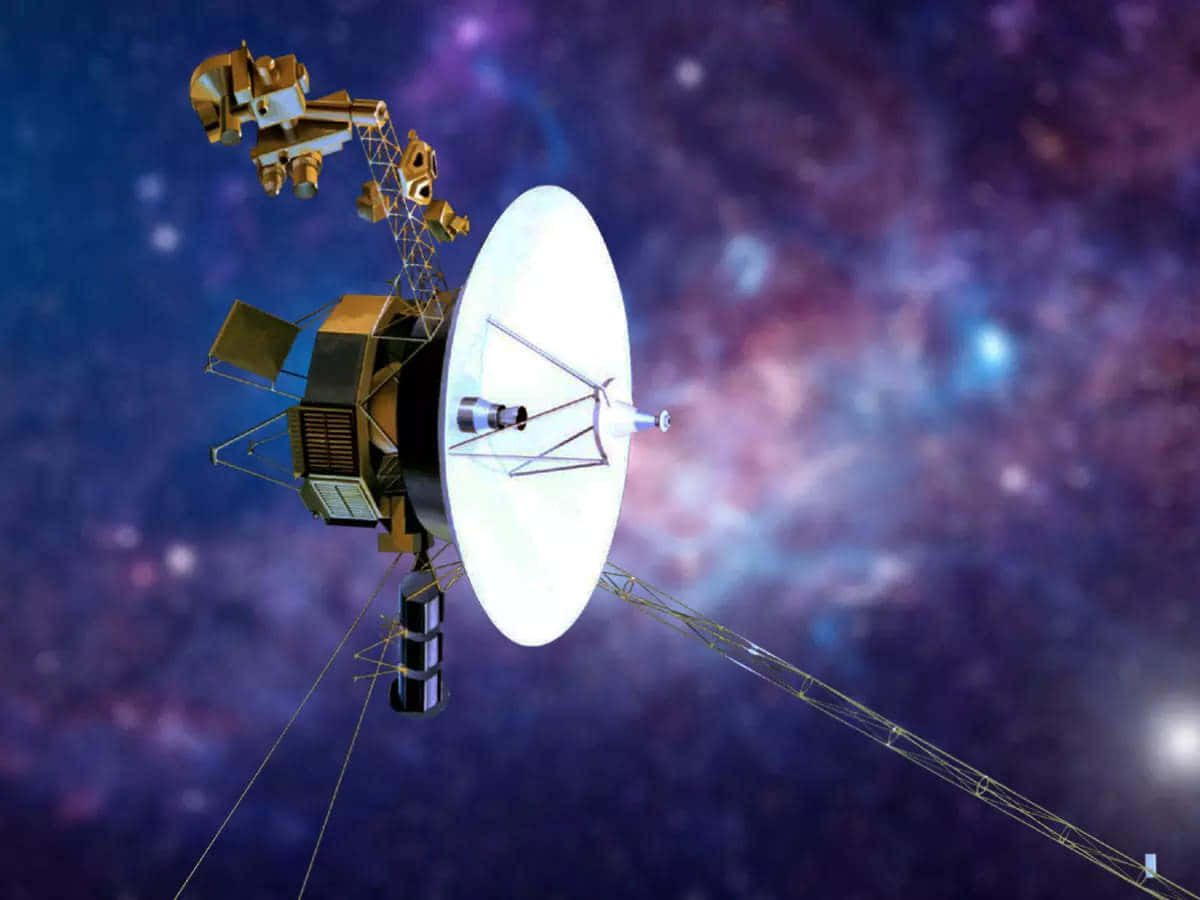
- Share Picture
- Embed Picture
Want to share this picture to your friends?
Want to embed this picture on your website or blog? Just copy the code below and paste it anywhere on your site.
Attribute this image
You must attribute the author and the source, when using this image. Copy the attribution details below and include them on your project or website.
- Ultra HD 4K

- Access to Members-only content
- Attribution-free downloads
- Unrestricted access to Tools
- First to try out new functions
How to attribute?
Generating content requires significanit dedication. heance we kiundly request that you acknokledge this work with an attribution to the URL of where you found it.
- Printed Items
- Apps and Games
This can be: Websites, social media pages, blog pages, e-books, newsletters, gifs, etc.
Copy and place the link near the image. If this is if not possible then place it near the footer of the website, blog, newsletter, or credits section.
This can be anything "offline" that's not on the web, e.g.: Books, clothing, posters, birthday cards, advertising etc.
Insert the attribution line: "Image from: Wallpapers.com." or "This has been designed using content from Wallpapers.com" close to the image you're using. If this isn't possible, then place it in the credits section.
Offline or Online Video platforms (Youtube, Vimeo, Dailymotion, etc.)
Paste the link below with the accompanied text in the video description area: This content derives from Wallpapers.com
For example: Apps, games, desktop apps, etc.
Paste the link below on the website where your app is available for download or in the descriptionfield of the platform or marketplace you're using to post your app, games or desktop apps.
- Unlimited attribution-free downloads
- Be the first to try out new functions
Related Voyager 1 Space Probe Pictures

Say thanks to zalina-kallaeva 🙏
Crediting isn’t required, but linking back is greatly appreciated and allows users like zalina-kallaeva to gain exposure. You can use the following text and code:

- The Contents
- The Making of
- Where Are They Now
- Frequently Asked Questions
- Q & A with Ed Stone
golden record
Where are they now.
- frequently asked questions
- Q&A with Ed Stone
Galleries of Images Voyager Took
The Voyager 1 and 2 spacecraft explored Jupiter, Saturn, Uranus and Neptune before starting their journey toward interstellar space. Here you'll find some of those iconic images, including "The Pale Blue Dot" - famously described by Carl Sagan - and what are still the only up-close images of Uranus and Neptune.
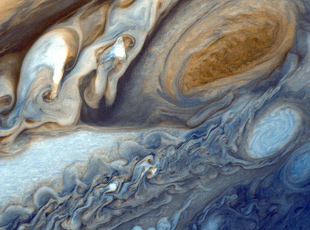
Photography of Jupiter began in January 1979, when images of the brightly banded planet already exceeded the best taken from Earth. Voyager 1 completed its Jupiter encounter in early April, after taking almost 19,000 pictures and many other scientific measurements. Voyager 2 picked up the baton in late April and its encounter continued into August. They took more than 33,000 pictures of Jupiter and its five major satellites.
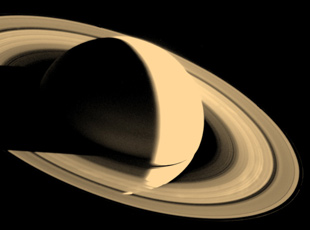
The Voyager 1 and 2 Saturn encounters occurred nine months apart, in November 1980 and August 1981. Voyager 1 is leaving the solar system. Voyager 2 completed its encounter with Uranus in January 1986 and with Neptune in August 1989, and is now also en route out of the solar system.
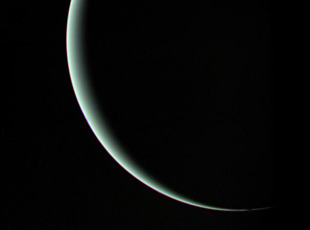
NASA's Voyager 2 spacecraft flew closely past distant Uranus, the seventh planet from the Sun, in January. At its closet, the spacecraft came within 81,800 kilometers (50,600 miles) of Uranus's cloudtops on Jan. 24, 1986. Voyager 2 radioed thousands of images and voluminous amounts of other scientific data on the planet, its moons, rings, atmosphere, interior and the magnetic environment surrounding Uranus.
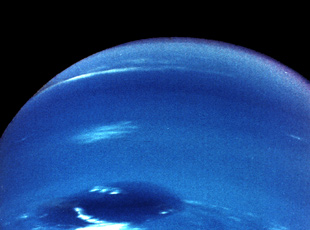
In the summer of 1989, NASA's Voyager 2 became the first spacecraft to observe the planet Neptune, its final planetary target. Passing about 4,950 kilometers (3,000 miles) above Neptune's north pole, Voyager 2 made its closest approach to any planet since leaving Earth 12 years ago. Five hours later, Voyager 2 passed about 40,000 kilometers (25,000 miles) from Neptune's largest moon, Triton, the last solid body the spacecraft will have an opportunity to study.
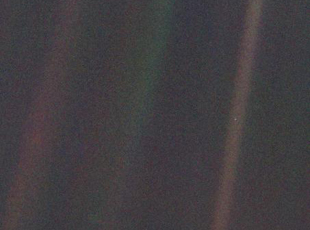
This narrow-angle color image of the Earth, dubbed 'Pale Blue Dot', is a part of the first ever 'portrait' of the solar system taken by Voyager 1. The spacecraft acquired a total of 60 frames for a mosaic of the solar system from a distance of more than 4 billion miles from Earth and about 32 degrees above the ecliptic. From Voyager's great distance Earth is a mere point of light, less than the size of a picture element even in the narrow-angle camera. Earth was a crescent only 0.12 pixel in size. Coincidentally, Earth lies right in the center of one of the scattered light rays resulting from taking the image so close to the sun. This blown-up image of the Earth was taken through three color filters -- violet, blue and green -- and recombined to produce the color image. The background features in the image are artifacts resulting from the magnification.

Suggested Searches
- Climate Change
- Expedition 64
- Mars perseverance
- SpaceX Crew-2
- International Space Station
- View All Topics A-Z
Humans in Space
Earth & climate, the solar system, the universe, aeronautics, learning resources, news & events.

NASA’s Fermi Mission Sees No Gamma Rays from Nearby Supernova

The Ocean Touches Everything: Celebrate Earth Day with NASA

The April 8 Total Solar Eclipse: Through the Eyes of NASA
- Search All NASA Missions
- A to Z List of Missions
- Upcoming Launches and Landings
- Spaceships and Rockets
- Communicating with Missions
- James Webb Space Telescope
- Hubble Space Telescope
- Why Go to Space
- Astronauts Home
- Commercial Space
- Destinations
- Living in Space
- Explore Earth Science
- Earth, Our Planet
- Earth Science in Action
- Earth Multimedia
- Earth Science Researchers
- Pluto & Dwarf Planets
- Asteroids, Comets & Meteors
- The Kuiper Belt
- The Oort Cloud
- Skywatching
- The Search for Life in the Universe
- Black Holes
- The Big Bang
- Dark Energy & Dark Matter
- Earth Science
- Planetary Science
- Astrophysics & Space Science
- The Sun & Heliophysics
- Biological & Physical Sciences
- Lunar Science
- Citizen Science
- Astromaterials
- Aeronautics Research
- Human Space Travel Research
- Science in the Air
- NASA Aircraft
- Flight Innovation
- Supersonic Flight
- Air Traffic Solutions
- Green Aviation Tech
- Drones & You
- Technology Transfer & Spinoffs
- Space Travel Technology
- Technology Living in Space
- Manufacturing and Materials
- Science Instruments
- For Kids and Students
- For Educators
- For Colleges and Universities
- For Professionals
- Science for Everyone
- Requests for Exhibits, Artifacts, or Speakers
- STEM Engagement at NASA
- NASA's Impacts
- Centers and Facilities
- Directorates
- Organizations
- People of NASA
- Internships
- Our History
- Doing Business with NASA
- Get Involved
- Aeronáutica
- Ciencias Terrestres
- Sistema Solar
- All NASA News
- Video Series on NASA+
- Newsletters
- Social Media
- Media Resources
- Upcoming Launches & Landings
- Virtual Events
- Sounds and Ringtones
- Interactives
- STEM Multimedia

NASA’s TESS Returns to Science Operations

NASA’s Near Space Network Enables PACE Climate Mission to ‘Phone Home’

NASA Photographer Honored for Thrilling Inverted In-Flight Image

NASA Open Science Initiative Expands OpenET Across Amazon Basin


NASA Motion Sickness Study Volunteers Needed!

NASA Selects New Crew for Next Simulated Mars Journey

Tech Today: Taking Earth’s Pulse with NASA Satellites

Kate A. McGinnis: Ready to “Go” with PACE Testing

A.3 Ocean Biology and Biogeochemistry Inclusion Plan Correction

NASA’s Ingenuity Mars Helicopter Team Says Goodbye … for Now

Comet Geyser: Perseverance’s 21st Rock Core

NASA’s Dragonfly Rotorcraft Mission to Saturn’s Moon Titan Confirmed

Astronauts To Patch Up NASA’s NICER Telescope

NASA’s Roman Space Telescope’s ‘Eyes’ Pass First Vision Test

Amendment 10: B.9 Heliophysics Low-Cost Access to Space Final Text and Proposal Due Date.

NASA Langley Team to Study Weather During Eclipse Using Uncrewed Vehicles

ARMD Solicitations
Earth Day 2024: Posters and Virtual Backgrounds

NASA Names Finalists of the Power to Explore Challenge

NASA Partnerships Bring 2024 Total Solar Eclipse to Everyone

NASA Receives 13 Nominations for the 28th Annual Webby Awards

A Solar Neighborhood Census, Thanks to NASA Citizen Science

La presentación del X-59 de la NASA personifica la tradición aeronáutica
Solar system portrait – earth as ‘pale blue dot’.

This narrow-angle color image of the Earth, dubbed ‘Pale Blue Dot’, is a part of the first ever ‘portrait’ of the solar system taken by Voyager 1. The spacecraft acquired a total of 60 frames for a mosaic of the solar system from a distance of more than 4 billion miles from Earth and about 32 degrees above the ecliptic. From Voyager’s great distance Earth is a mere point of light, less than the size of a picture element even in the narrow-angle camera. Earth was a crescent only 0.12 pixel in size. Coincidentally, Earth lies right in the center of one of the scattered light rays resulting from taking the image so close to the sun. This blown-up image of the Earth was taken through three color filters – violet, blue and green – and recombined to produce the color image. The background features in the image are artifacts resulting from the magnification. For more information about the Voyager spacecraft, visit https://www.nasa.gov/voyager and http://voyager.jpl.nasa.gov . Image credit: NASA/JPL-Caltech
NASA engineers discover why Voyager 1 is sending a stream of gibberish from outside our solar system
Voyager 1 has been sending a stream of garbled nonsense since November. Now NASA engineers have identified the fault and found a potential workaround.
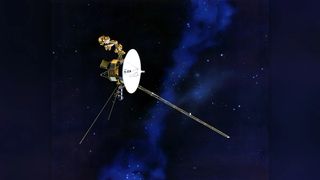
For the past five months, the Voyager 1 spacecraft has been sending a steady stream of unreadable gibberish back to Earth. Now, NASA engineers finally know why.
The 46-year-old spacecraft sends regular radio signals as it drifts further from our solar system . But in November 2023, the signals suddenly became garbled, meaning scientists were unable to read any of its data, and they were left mystified about the fault's origins.
In March, NASA engineers sent a command prompt, or "poke," to the craft to get a readout from its flight data subsystem (FDS) — which packages Voyager 1's science and engineering data before beaming it back to Earth.
After decoding the spacecraft's response, the engineers have found the source of the problem: The FDS's memory has been corrupted.
Related: NASA's Voyager 1 sends readable message to Earth after 4 nail-biting months of gibberish
"The team suspects that a single chip responsible for storing part of the affected portion of the FDS memory isn't working," NASA said in a blog post Wednesday (March 13) . "Engineers can't determine with certainty what caused the issue. Two possibilities are that the chip could have been hit by an energetic particle from space or that it simply may have worn out after 46 years."
— NASA hears 'heartbeat' signal from Voyager 2 probe a week after losing contact
— Historic space photo of the week: Voyager 2 spies a storm on Saturn 42 years ago
— NASA reestablishes full contact with Voyager 2 probe after nail-biting 2-week blackout
Although it may take several months, the engineers say they can find a workaround to run the FDS without the fried chip — restoring the spacecraft's messaging output and enabling it to continue to send readable information from outside our solar system.
Sign up for the Live Science daily newsletter now
Get the world’s most fascinating discoveries delivered straight to your inbox.
Launched in 1977, Voyager 1 zipped past Saturn and Jupiter in 1979 and 1980 before flying out into interstellar space in 2012. It is now recording the conditions outside of the sun's protective magnetic field , or heliosphere, which blankets our solar system.
Voyager 1 is currently more than 15 billion miles (24 billion kilometers) from Earth, and it takes 22.5 hours for any radio signal to travel from the craft to our planet.

Ben Turner is a U.K. based staff writer at Live Science. He covers physics and astronomy, among other topics like tech and climate change. He graduated from University College London with a degree in particle physics before training as a journalist. When he's not writing, Ben enjoys reading literature, playing the guitar and embarrassing himself with chess.
Object that slammed into Florida home was indeed space junk from ISS, NASA confirms
NASA spacecraft snaps mysterious 'surfboard' orbiting the moon. What is it?
AI pinpoints where psychosis originates in the brain
- TorbjornLarsson Bon voyage, Voyager! Reply
- Jay McHue What if aliens are doing it to try to communicate with us? 🤪 Reply
Jay McHue said: What if aliens are doing it to try to communicate with us? 🤪
admin said: Voyager 1 has been sending a stream of garbled nonsense since November. Now NASA engineers have identified the fault and found a potential workaround. NASA engineers discover why Voyager 1 is sending a stream of gibberish from outside our solar system : Read more
sourloaf said: What does FSB mean?
Rusty Lugnuts said: Where are you seeing "FSB"? The closest thing I can see in the article is "FDS". In modern computers, FSB would most likely refer to the Fr0nt S1ide Bu5, though I have no idea if a system as old as Voyagers, let alone engineered so specifically, would have an FSB. (apparently I can't spell out "Fr0nt S1ide Bu5" or my post gets flagged as spam or inappropriate??)
- SkidWard Just cut the % of ram needed... skip the bad sectors Reply
- kloudykat FDS = fl1ght da1a sub5ystem5 Reply
- 5ft24dave This is pretty old news, like 6 months old. Are you guys just now discovering this? Reply
Commodore Browncoat said: That's about as sane a theory as many of the others that have become ridiculously popular in the past several years, so sure - why not? What reply do you think we should send?
- View All 11 Comments
Most Popular
- 2 Infamous boat-sinking orcas spotted hundreds of miles from where they should be, baffling scientist
- 3 Pluto's huge white 'heart' has a surprisingly violent origin, new study suggests
- 4 Most massive stellar black hole in the Milky Way discovered 'extremely close' to Earth
- 5 2,000-foot-wide 'potentially hazardous' asteroid has just made its closest approach to Earth — and you can see it with a telescope
- 2 Most massive stellar black hole in the Milky Way discovered 'extremely close' to Earth
- 3 Tired of your laptop battery degrading? New 'pulse current' charging process could double its lifespan.
- 4 Infamous boat-sinking orcas spotted hundreds of miles from where they should be, baffling scientist

IMAGES
VIDEO
COMMENTS
Each Voyager space probe carries a gold-plated audio-visual disc in the event that the spacecraft is ever found by intelligent life forms from other planetary systems. Examine the images and sounds of planet earth. Images Voyager Took The Voyager 1 and 2 spacecraft explored Jupiter, Saturn, Uranus and Neptune before starting their journey ...
In celebration of Voyagers' Interstellar voyage, we've added these Posters and Infographics for you to download, print, and share.
Spacecraft: Instrument: Click on an image for detailed information ... Early Voyager 1 Images of Jupiter Full Resolution: TIFF (491.5 kB) JPEG (21.78 kB) 1996-09-26: Jupiter: Voyager: Imaging Science Subsystem: 400x400x3: PIA00029: First Close-up Image of Jupiter from ...
2160x4680 Voyager 1 Was The Night (2160x4680)">. Get Wallpaper. 1600x1200 NASA Voyager 1: Facts About the Only Spacecraft to Leave Solar System on Anniversary of Launch">. Get Wallpaper. 3840x2160 Astronaut Voyager, HD Artist, 4k Wallpaper, Image, Background, Photo and Picture">. Get Wallpaper.
This is an image of the planet Uranus taken by the spacecraft Voyager 2 in 1986. Credit: NASA/JPL-Caltech. Full Image Details. This image, taken by NASA's Voyager 2 early in the morning of Aug. 23, 1989, is a false color image of Triton, Neptune's largest satellite; mottling in the bright southern hemisphere is present.
Spacecraft: Go to PIAxxxxx: Refine this list of images by: ... First Close-up Image of Jupiter from Voyager 1 Full Resolution: TIFF (280.8 kB) JPEG (10.37 kB) 1996-09-26: Jupiter: Voyager: VG ISS - Narrow Angle: 500x500x3: PIA00455: Jupiter with Io Crossing Full Resolution ...
Images of Voyager Get an in-depth look at the science instruments aboard the Voyager spacecraft, plus diagrams illustrating the spacecraft's trajectory, orbit and mechanics. Here you'll also find a number of artist's concepts explaining the anatomy of our solar system and the Voyagers' journey to reach interstellar space.
A Voyager probe took this false-color image of Saturn's rings on August 23, 1981. Neptune, as seen by Voyager 2 in 1989. The Voyager program was able to take advantage of a moment of cosmic ...
An artist's rendering of one of the Voyager spacecraft. Image credit: NASA. The Voyager 1 and 2 spacecraft launched from Earth in 1977. Their mission was to explore Jupiter and Saturn—and beyond to the outer planets of our solar system. This was a big task. No human-made object had ever attempted a journey like that before.
Voyager 1. Favorite. Explore stunning Voyager 1-themed artworks, wallpapers, and gifs on our platform, celebrating humanity's iconic journey into interstellar space. Discover and download captivating tributes to this pioneering spacecraft created by talented artists worldwide. Filter: 20. HD Wallpaper (2560x1440) 4,396.
Check out this fantastic collection of Star Trek Voyager wallpapers, with 33 Star Trek Voyager background images for your desktop, phone or tablet. ... 2560x1440 Voyager Spacecraft Wallpaper. Orion"> Get Wallpaper. 1917x1195 Sci Fi Trek Fiction Wallpaper"> Get Wallpaper. 3840x2400 Star Trek: Voyager HD Wallpaper">
Feb. 12, 2020. Context Image. This simulated view, made using NASA's Eyes on the Solar System app, approximates Voyager 1's perspective when it took its final series of images known as the "Family Portrait of the Solar System," including the "Pale Blue Dot" image. Figure 1 shows the location of each image. Download JPG.
3840x2160. 5120×2880. 7680x4320. License type: Free. Attribution is required. File type: JPG. A excellent pictures of a Voyager 1 space probe with galaxy sky view. Multiple sizes available for all screen sizes and devices. 100% Free and No Sign-Up Required.
Feb 12, 2020. Article. This updated version of the iconic "Pale Blue Dot" image taken by the Voyager 1 spacecraft uses modern image-processing software and techniques to revisit the well-known Voyager view while attempting to respect the original data and intent of those who planned the images. Credits: NASA/JPL-Caltech.
Check out this fantastic collection of Space Probe wallpapers, with 63 Space Probe background images for your desktop, phone or tablet. ... 1280x720 Voyager"> Get Wallpaper. 1920x1080 Download Space Probe HD Wallpaper Free To Download For iPhone Mobile Wallpaper"> Get Wallpaper. 3000x2400 spacecraft wallpaper, satellite, outer space, space ...
voyager probe. Download free Satellites wallpapers and desktop backgrounds! Hi everyone! We're hard at work trying to keep ... 1,696,349 Wallpapers; 1,565,068 Members; 12,971,712 Votes; 5,965,287 Favorites; Desktop Nexus Wallpapers. Home. Explore. Wallpaper Galleries: Abstract Aircraft Animals Anime Architecture Boats Cars Entertainment ...
3840x2160 Voyager spacecraft Wallpaper Background Image. View, download, comment, and rate - Wallpaper Abyss . ... Voyager spacecraft 7 years ago Auto Load Next 1920x1080 - Sci ...
Galleries of Images Voyager Took. The Voyager 1 and 2 spacecraft explored Jupiter, Saturn, Uranus and Neptune before starting their journey toward interstellar space. Here you'll find some of those iconic images, including "The Pale Blue Dot" - famously described by Carl Sagan - and what are still the only up-close images of Uranus and Neptune.
Scroll up this page. Tons of awesome Voyager 1 wallpapers to download for free. You can also upload and share your favorite Voyager 1 wallpapers. HD wallpapers and background images.
Favorite. Explore a premium collection of 4K Ultra HD Star Trek: Voyager wallpapers, perfect for elevating your desktop. Filter: All Wallpapers PFP. You'll Love: Star Trek Star Trek: The Original Series Star Trek: Picard And More! 5. 4K+ Ultra HD (4750x2672) 3,875. Tags. 12.
The spacecraft acquired a total of 60 frames for a mosaic of the solar system from a distance of more than 4 billion miles from Earth and about 32 degrees above the ecliptic. This narrow-angle color image of the Earth, dubbed 'Pale Blue Dot', is a part of the first ever 'portrait' of the solar system taken by Voyager 1.
Voyager Spacecraft Wallpaper. 1999 views 281 downloads. Explore a curated colection of Voyager Spacecraft Wallpaper Images for your Desktop, Mobile and Tablet screens. We've gathered more than 5 Million Images uploaded by our users and sorted them by the most popular ones. Follow the vibe and change your wallpaper every day!
3. HD Wallpaper (1920x1200) 2,919. Tags Voyager 2 Neptune Sci Fi. 16. 4K+ Ultra HD (3840x2160) 9,105. Tags Voyager 2 Neptune Space Sci Fi Satellite. [All Sizes 100% Free Crop And Personalize]: Adorn your desktop with breath-taking HD wallpapers of the Voyager 2 spacecraft - embark on a visual journey into the realms of space exploration.
The 46-year-old spacecraft sends regular radio signals as it drifts further from our solar system. But in November 2023, the signals suddenly became garbled, meaning scientists were unable to read ...